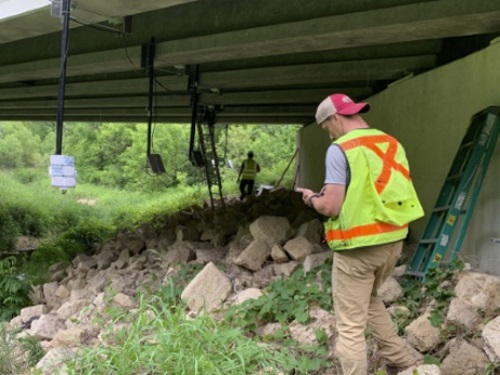The Minnesota Department of Transportation is helping test ultrasonic bat “deterrence devices” at two bridges to help keep the mammals away from such structures when they undergo maintenance and/or repair activity.
[Above photo by the Minnesota DOT]
The agency noted in a blog post that bats like to roost in bridge expansion joints and temporarily preventing such roosting during bridge maintenance repair activity typically requires installing physical barriers that are often difficult to establish effectively, due to the design characteristics of many structures.
More importantly, the Minnesota DOT does not necessarily want to keep bats away permanently from its bridges because bat populations throughout North America are in serious decline. For example, the agency said white-nose syndrome – a fungal disease – has killed more than 5.7 million bats in eastern North America since 2005. On top of that, wind turbines kill hundreds of thousands of bats in North America annually, according to a study by the U.S. Geological Survey.
The Minnesota DOT has worked with the Minnesota Department of Natural Resources and the U.S. Fish and Wildlife Service for the last two years testing battery-operated ultrasonic deterrence devices that reduce bat activity at bridge site when activated, but ensure a quick return of bat roosting activity when deactivated.
“This project was innovative. We worked with a technology that wasn’t really on the market yet for real-world applications in anticipation of its availability,” noted Christopher Smith, wildlife ecologist with the Minnesota DOT’s Office of Environmental Stewardship.
He added that current regulations require shorter maintenance period options during the construction season in order to protect bats – mandating that crews must avoid having bats present during their work, which impacts cleaning, painting, and other maintenance timelines.
“The presence of bats disrupts bridge work timelines and budgets, and work upsets habitation for species struggling to survive,” Smith said.
The Minnesota DOT noted that it hopes to develop a procedure for deploying this ultrasonic bat deterrence technology when needed and determine associated expenses from this two-year research effort.
Further study could consider the technology in different configurations and environments, test the devices at many bridges around the country, and conduct a cost-benefit analysis, the agency added – while also comparing the “relative impact” of acoustic deterrents on specific bat species.

